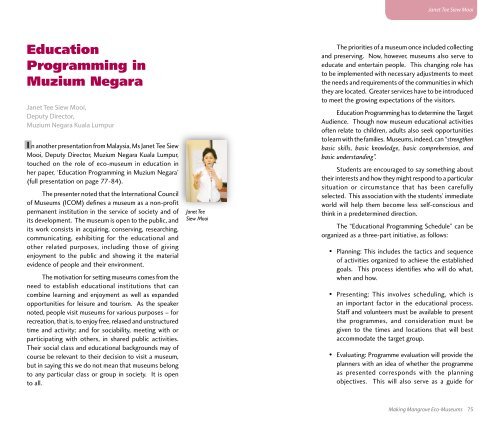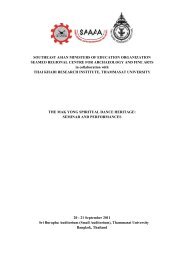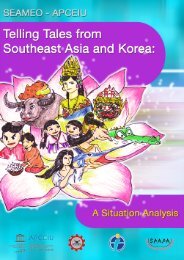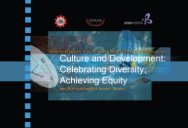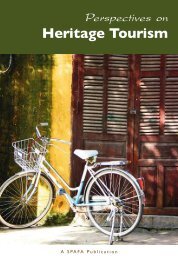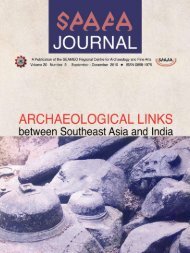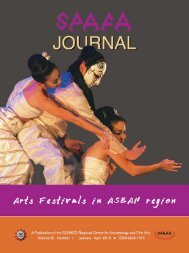Making Mangrove - Seameo-SPAFA
Making Mangrove - Seameo-SPAFA
Making Mangrove - Seameo-SPAFA
Create successful ePaper yourself
Turn your PDF publications into a flip-book with our unique Google optimized e-Paper software.
Janet Tee Siew MooiEducationProgramming inMuzium NegaraJanet Tee Siew Mooi,Deputy Director,Muzium Negara Kuala LumpurI n another presentation from Malaysia, Ms Janet Tee SiewMooi, Deputy Director, Muzium Negara Kuala Lumpur,touched on the role of eco-museum in education inher paper, ‘Education Programming in Muzium Negara’(full presentation on page 77-84).The presenter noted that the International Councilof Museums (ICOM) defines a museum as a non-profitpermanent institution in the service of society and ofits development. The museum is open to the public, andits work consists in acquiring, conserving, researching,communicating, exhibiting for the educational andother related purposes, including those of givingenjoyment to the public and showing it the materialevidence of people and their environment.The motivation for setting museums comes from theneed to establish educational institutions that cancombine learning and enjoyment as well as expandedopportunities for leisure and tourism. As the speakernoted, people visit museums for various purposes – forrecreation, that is, to enjoy free, relaxed and unstructuredtime and activity; and for sociability, meeting with orparticipating with others, in shared public activities.Their social class and educational backgrounds may ofcourse be relevant to their decision to visit a museum,but in saying this we do not mean that museums belongto any particular class or group in society. It is opento all.Janet TeeSiew MooiThe priorities of a museum once included collectingand preserving. Now, however, museums also serve toeducate and entertain people. This changing role hasto be implemented with necessary adjustments to meetthe needs and requirements of the communities in whichthey are located. Greater services have to be introducedto meet the growing expectations of the visitors.Education Programming has to determine the TargetAudience. Though now museum educational activitiesoften relate to children, adults also seek opportunitiesto learn with the families. Museums, indeed, can “strengthenbasic skills, basic knowledge, basic comprehension, andbasic understanding”.Students are encouraged to say something abouttheir interests and how they might respond to a particularsituation or circumstance that has been carefullyselected. This association with the students’ immediateworld will help them become less self-conscious andthink in a predetermined direction.The “Educational Programming Schedule” can beorganized as a three-part initiative, as follows:• Planning: This includes the tactics and sequenceof activities organized to achieve the establishedgoals. This process identifies who will do what,when and how.• Presenting: This involves scheduling, which isan important factor in the educational process.Staff and volunteers must be available to presentthe programmes, and consideration must begiven to the times and locations that will bestaccommodate the target group.• Evaluating: Programme evaluation will provide theplanners with an idea of whether the programmeas presented corresponds with the planningobjectives. This will also serve as a guide for<strong>Making</strong> <strong>Mangrove</strong> Eco-Museums 75


